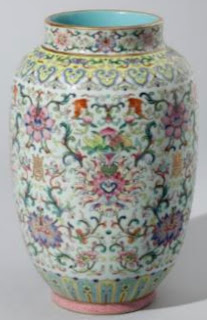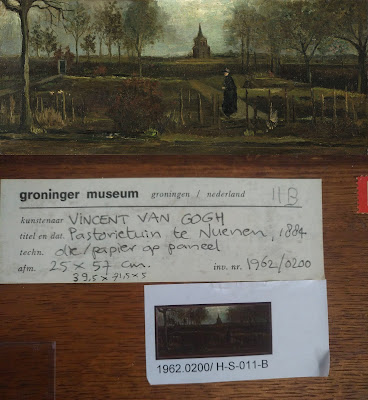"This Plaque was smuggled out of Italy by antiquities trafficker Eugene Alexander and into New York through the dealer Michael Ward, who was convicted this past September of Criminal Facilitation."Inside what has come to be a rather boiler plate restitution press release announcing the return of 19 additional antiquities to Italy, the New York District Attorney's Office in Manhattan, slipped in a nice little Easter Egg when highlighting three of the object's heading back to Italy. All had connections to well known antiquities traffickers, Gianfranco Becchina, Raffaele Monticelli, Jerome Eisenberg, Edoardo Almagià and Eugene Alexander.
Along with these well-known names, the one line sentence quoted above refers to Michael L. Ward (b. 1943), the New York city antiquities dealer who managed a series of eponymous ancient art business entities, including:
- Ward & Company Works of Art, LLC
- Ward & Company Works of Art I, LLC
- Ward & Company Works of Art, Inc.
- Ward & Company, Fine Art, Inc.
- Michael Ward Inc.
And yes, this is the same fox in the the federal government's chicken coop who was previously appointed by then-President George H. W. Bush in 1992 to serve on the United States Cultural Property Advisory Committee, the U.S. statutory body who is responsible for the domestic implementation of the UNESCO Convention on the Means of Prohibiting and Preventing the Illicit Import, Export and Transfer of Ownership of Cultural Property of 1970.
Shortly after Ward's presidential appointment, the dealer found himself under the unwanted spotlight for attempting to sell 50 pieces of important Mycenaean jewellery, referred to as the Aidonia Treasure. Dating to the 15th century BCE, these gold funerary pieces had been plundered in 1978 from a Mycenaean cemetery at Aidonia, near Nemea, in southern Greece.
On 30 December 1993 Ward finagled his way out of his first messy situation via an out-of-court settlement wherein Greece agreed to drop their lawsuit against Ward and his gallery and Ward's gallery was allowed to donate the looted jewellery to the newly formed Society for the Preservation of Greek Heritage in Washington, D.C.
In a stitch-up similar to Leonard Stern's later gifting of 161 works of Cycladic art via the Institute of Ancient Greek Culture of Delaware, Ward’s strategic use of, and donation to, a nonprofit charitable organisation enabled him to recoup his acquisition costs via a nice sized federal income-tax write-off.
Evidently, undeterred by this close call, the New York dealer continued to take risks, (and profited from) the purchase and sale of illicit antiquities via several networks of suppliers, who one by one, and over many years, were unveiled as corrupt.
Ward's own "skin in the game" is clearly spelled out, beginning on page 114 of the Michael Steinhardt Statement of Facts document, where it is stated:
During this time, he [Ward] bought antiquities directly from known traffickers such as Giovanni Franco Becchina and Edoardo Almagià. He then sold them— typically with no listed provenance—to U.S. museums and prominent collectors, including Lawrence and Barbara Fleischman and Steinhardt. Ward’s attitude for due diligence and provenance is demonstrated by a 1992 fax to Steinhardt, in which he advises Steinhardt that “[t]he more you inquire about details of ownership, etc. the less likely you will appear (if there is, God forbid a question) a credible bona fide purchaser. Michael, you want to appear as dumb as possible!”
This document also describes Ward’s connection to the network of Italian dealer Gianfranco Becchina and as the direct purchaser of more than a dozen looted Italian artefacts documented in the business records of antiquities trafficker Edoardo Almagià.
But before highlighting just a few of the curious examples of plundered material handled by Ward, let's explore the charge he plead guilty to on September 8, 2023.
New York Penal Law § 115.00 (1) Criminal Facilitation in the Fourth Degree
In many states, if a criminal helps another person commit a crime, they too have themselves committed a crime. In the state of New York there are four different criminal facilitation crimes, the least serious of which, under New York Penal Law, is criminal facilitation in the fourth degree, a class A misdemeanor.
In order for Michael Ward to be found guilty under New York Penal Law § 115.00, the state of New York is required to prove, from all of the probative evidence gathered in this case, beyond a reasonable doubt, each of the following three elements:
Satisfying elements 1 and 2
According to Ward's criminal complaint, filed with the Criminal Court of the City of New York, County of New York on September 6, 2023, this dealer operated his gallery at 980 Madison Avenue, (between East 76th Street and East 77th) in the County and State of New York from 1982 onward, opening his first business on 4 June 1982 to be precise. The criminal complaint also states that from 1999 through 2022, Ward facilitated a money laundering scheme initiated by Eugene Alexander which involved selling looted antiquities from several countries onward to European and American collectors.
Alexander’s antiquities-trafficking operation, also mentioned in the Michael Steinhardt Statement of Facts document involved the use of local looters operating in Eastern Europe and the Mediterranean who sent Alexander photos of freshly excavated antiquities. Once selected, Alexander had the illicit objects smuggled into Germany where he had the artefacts cleaned and restored, sometimes using the restorer Flavio Bertolin and authenticating the pieces via Thermoluminescence (TL) Analysis conducted by Ralf Kotalla (who also sent authentication reports to other traffickers, including Gianfranco Becchina). Once the artefacts had been tidied up and were ready for prime time, many of them made their way into important collections in the United States.
Alexander is noted in Ward's indictment for circulating artefacts to individuals such as Michael Steinhardt, to Richard Beale of Roma Numismatics, and to Erdal Dere of Fortuna Galleries, among others. To do so he used a series of shell corporations and offshore banks for payments.
In September 2020
the US Attorney in the Southern District of New York issued an indictment against
Erdal Dere and Faisal Khan, the operators of Fortuna Fine Arts, charging them with defrauding antiquities buyers and brokers by using false provenances to offer and sell antiquities. That case is ongoing.
Richard Beale, the director of London-based auction house Roma Numismatics, pled guilty on 14 August 2023 to two counts of conspiracy, and three counts of criminal possession of stolen property, for his role in the sale of the gold Eid Mar coin, which fetched $4.19m (£3.29m) in 2020, and an ancient silver Sicily Naxos Coin, which sold at the same time for $292,000.
Ward's criminal complaint states that as many as 80 of Alexander's looted antiquities passed through Ward's New York gallery between 2015 and 2019. For dozens of these, the collection histories vaguely listed their provenance as coming from an "ex Geneva private collection, acquired in the early 1990s" or similarly worded claims such as "ex Geneva private collection, acquired in the early 1980s."
Ward's complaint also states that HSI, the principal investigative arm of the U.S. Department of Homeland Security, recovered more than 35 of these suspect antiquities while executing a search and seizure warrant in New York on 5 September 2023 which he relinquished upon pleading guilty.
Reviews of confiscated emails also demonstrate that Ward was involved in the facilitation of written documents which furthered Eugene Alexander's money-laundering enterprise, four of which were outlined in the complaint as:
- a July 30, 2017 document with Eugene Alexander, indicating that Ward accepted on consignment 89 antiquities valued at over $20 million.
- an October 30, 2018 document with Eugene Alexander, indicating that Ward accepted on consignment another 82 antiquities valued at over $27 million.
- a January 10, 2019 blank form, provided by Eugene Alexander, used to state that on April 1, 2019, that Alexander had consigned or sold Ward 63 antiquities valued at over $29 million.
- and a January 25, 2019 document on Ward & Company letterhead with the Ward's signature that indicated Ward owed Eugene Alexander more than $4 million.
Germany authorities, conducting a parallel investigation, executed a raid on Eugene Alexander's apartment on February 23, 2022, and recovered, among many objects, Alexander's computers, as well as incriminating correspondence between the Bulgarian dealer, traffickers, and the American gallerist. Also recovered were photographs that looters had sent to Alexander depicting freshly looted antiquities prior to their being cleaned or restored. After the objects were made presentable, Alexander, with Ward's assistance, successfully sold many of the laundered pieces onward, with vague fabricated provenance documents and the occasional Art Loss Register certificate.
Satisfying element 3
According to the testimony of HSI-ICE Special Agent Robert Fromkin, who reviewed the communications between Ward and Eugene Alexander, the volume of documented transactions involving looted antiquities between the two men, as well as the depiction of transactions that never actually occurred between the pair, or that repeated themselves over several documents, concretely confirmed that Ward had rendered aid to a person, in this instance Eugene Alexander, who intended to commit a crime, and had engaged in conduct which provided said person with the means and opportunity for the commission thereof, and which in fact aided said individual, in committing a felony.
A brief look at a few of the pieces handled by Ward & Company.
 |
| Cyrene Deity - Steinhardt-Albertson Dt.76* |
While the number of suspect antiquities sold by Mr. Ward to his wealthy clientele are too numerous to document in this single article, a few stand out and are worth mentioning, including this 2.5 meter tall 3rd - 2nd century BCE funerary monument, pictured at right, which represents a half-figure goddess.A strikingly rare piece, this sculpture is likewise named in the Michael Steinhardt Statement of Facts, and was formally surrendered by the disgraced New York collector-mogul in early December 2021. One of only ten known half-figured goddesses of this type, originating from the Necropolis of Cyrene, Steinhardt had purchased Dt.76 from Michael L. Ward on 20 November 2000 for the spritely sum of $1,200,000.
On Ward's invoice, the plundered "Veiled Head of a Female" was described colourfully as:
“possibly from North Africa”and had “a light brown earthy deposit uniformly covering the head imparts to its surfaces an attractive, warm patina.”
"Earthy deposits", all but screaming to the billionaire buyer that his purchase was freshly looted material, never before part of a known or established collection.
Some Ward Objects are in important Museum Collections
In 2003 this 350 BCE Greek seated marble figure from a Grave Naiskos was accessioned into the collection of the Michael C. Carlos Museum and assigned object number 2003.005.001
The provenance is listed as:
From 1986 to 1992 Michael Ward is also known to have sold numerous artefacts to Lawrence and Barbara Fleischman, some of which were later donated to the J. Paul Getty Museum. Other pieces can be found in the accession records of other US Museums.
The Krater of Koreshnica, as it has come to be known, was looted on/around 1996
from a 6th century BCE Macedonian burial chamber near the village of Koreshnica, in the southern part of the Republic of Macedonia before being smuggled out of the country in contravention of the country's national law.
If Michel Van Rijn's statements are to be believed, the circulation of this looted object via Tkalec, adds yet another smuggling network to Mr. Ward's growing list of suspect supply chains.
By: Lynda Albertson
 Anton Tkalec,Eugene Alexander,Gianfranco Becchina,Leon Levy,Michael C. Carlos Museum,Michael Ward,Michel van Rijn,Museum of Fine Art Houston,Shelby White
Anton Tkalec,Eugene Alexander,Gianfranco Becchina,Leon Levy,Michael C. Carlos Museum,Michael Ward,Michel van Rijn,Museum of Fine Art Houston,Shelby White
 No comments
No comments





































.png)






